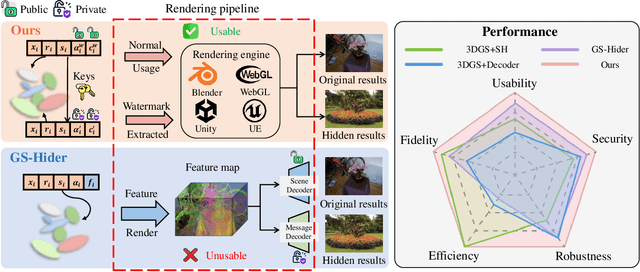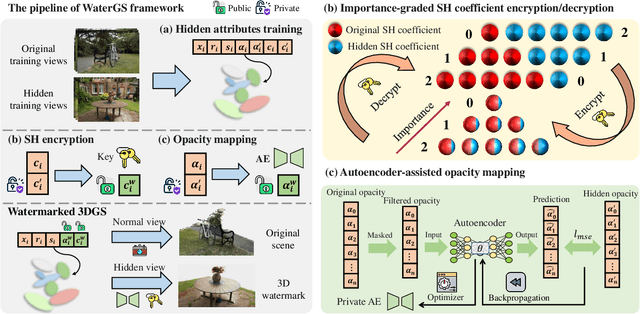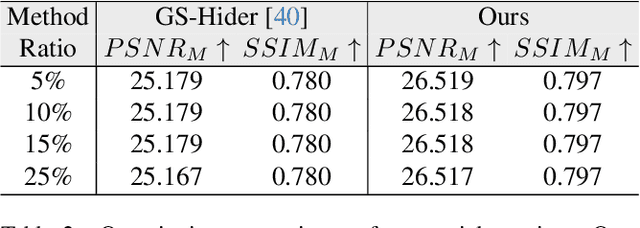Tiejun Huang
Inter-event Interval Microscopy for Event Cameras
Apr 08, 2025Abstract:Event cameras, an innovative bio-inspired sensor, differ from traditional cameras by sensing changes in intensity rather than directly perceiving intensity and recording these variations as a continuous stream of "events". The intensity reconstruction from these sparse events has long been a challenging problem. Previous approaches mainly focused on transforming motion-induced events into videos or achieving intensity imaging for static scenes by integrating modulation devices at the event camera acquisition end. In this paper, for the first time, we achieve event-to-intensity conversion using a static event camera for both static and dynamic scenes in fluorescence microscopy. Unlike conventional methods that primarily rely on event integration, the proposed Inter-event Interval Microscopy (IEIM) quantifies the time interval between consecutive events at each pixel. With a fixed threshold in the event camera, the time interval can precisely represent the intensity. At the hardware level, the proposed IEIM integrates a pulse light modulation device within a microscope equipped with an event camera, termed Pulse Modulation-based Event-driven Fluorescence Microscopy. Additionally, we have collected IEIMat dataset under various scenes including high dynamic range and high-speed scenarios. Experimental results on the IEIMat dataset demonstrate that the proposed IEIM achieves superior spatial and temporal resolution, as well as a higher dynamic range, with lower bandwidth compared to other methods. The code and the IEIMat dataset will be made publicly available.
SpikeDerain: Unveiling Clear Videos from Rainy Sequences Using Color Spike Streams
Mar 26, 2025Abstract:Restoring clear frames from rainy videos presents a significant challenge due to the rapid motion of rain streaks. Traditional frame-based visual sensors, which capture scene content synchronously, struggle to capture the fast-moving details of rain accurately. In recent years, neuromorphic sensors have introduced a new paradigm for dynamic scene perception, offering microsecond temporal resolution and high dynamic range. However, existing multimodal methods that fuse event streams with RGB images face difficulties in handling the complex spatiotemporal interference of raindrops in real scenes, primarily due to hardware synchronization errors and computational redundancy. In this paper, we propose a Color Spike Stream Deraining Network (SpikeDerain), capable of reconstructing spike streams of dynamic scenes and accurately removing rain streaks. To address the challenges of data scarcity in real continuous rainfall scenes, we design a physically interpretable rain streak synthesis model that generates parameterized continuous rain patterns based on arbitrary background images. Experimental results demonstrate that the network, trained with this synthetic data, remains highly robust even under extreme rainfall conditions. These findings highlight the effectiveness and robustness of our method across varying rainfall levels and datasets, setting new standards for video deraining tasks. The code will be released soon.
Towards High-performance Spiking Transformers from ANN to SNN Conversion
Feb 28, 2025Abstract:Spiking neural networks (SNNs) show great potential due to their energy efficiency, fast processing capabilities, and robustness. There are two main approaches to constructing SNNs. Direct training methods require much memory, while conversion methods offer a simpler and more efficient option. However, current conversion methods mainly focus on converting convolutional neural networks (CNNs) to SNNs. Converting Transformers to SNN is challenging because of the presence of non-linear modules. In this paper, we propose an Expectation Compensation Module to preserve the accuracy of the conversion. The core idea is to use information from the previous T time-steps to calculate the expected output at time-step T. We also propose a Multi-Threshold Neuron and the corresponding Parallel Parameter normalization to address the challenge of large time steps needed for high accuracy, aiming to reduce network latency and power consumption. Our experimental results demonstrate that our approach achieves state-of-the-art performance. For example, we achieve a top-1 accuracy of 88.60\% with only a 1\% loss in accuracy using 4 time steps while consuming only 35\% of the original power of the Transformer. To our knowledge, this is the first successful Artificial Neural Network (ANN) to SNN conversion for Spiking Transformers that achieves high accuracy, low latency, and low power consumption on complex datasets. The source codes of the proposed method are available at https://github.com/h-z-h-cell/Transformer-to-SNN-ECMT.
Rethinking High-speed Image Reconstruction Framework with Spike Camera
Jan 08, 2025Abstract:Spike cameras, as innovative neuromorphic devices, generate continuous spike streams to capture high-speed scenes with lower bandwidth and higher dynamic range than traditional RGB cameras. However, reconstructing high-quality images from the spike input under low-light conditions remains challenging. Conventional learning-based methods often rely on the synthetic dataset as the supervision for training. Still, these approaches falter when dealing with noisy spikes fired under the low-light environment, leading to further performance degradation in the real-world dataset. This phenomenon is primarily due to inadequate noise modelling and the domain gap between synthetic and real datasets, resulting in recovered images with unclear textures, excessive noise, and diminished brightness. To address these challenges, we introduce a novel spike-to-image reconstruction framework SpikeCLIP that goes beyond traditional training paradigms. Leveraging the CLIP model's powerful capability to align text and images, we incorporate the textual description of the captured scene and unpaired high-quality datasets as the supervision. Our experiments on real-world low-light datasets U-CALTECH and U-CIFAR demonstrate that SpikeCLIP significantly enhances texture details and the luminance balance of recovered images. Furthermore, the reconstructed images are well-aligned with the broader visual features needed for downstream tasks, ensuring more robust and versatile performance in challenging environments.
Source-free Semantic Regularization Learning for Semi-supervised Domain Adaptation
Jan 02, 2025



Abstract:Semi-supervised domain adaptation (SSDA) has been extensively researched due to its ability to improve classification performance and generalization ability of models by using a small amount of labeled data on the target domain. However, existing methods cannot effectively adapt to the target domain due to difficulty in fully learning rich and complex target semantic information and relationships. In this paper, we propose a novel SSDA learning framework called semantic regularization learning (SERL), which captures the target semantic information from multiple perspectives of regularization learning to achieve adaptive fine-tuning of the source pre-trained model on the target domain. SERL includes three robust semantic regularization techniques. Firstly, semantic probability contrastive regularization (SPCR) helps the model learn more discriminative feature representations from a probabilistic perspective, using semantic information on the target domain to understand the similarities and differences between samples. Additionally, adaptive weights in SPCR can help the model learn the semantic distribution correctly through the probabilities of different samples. To further comprehensively understand the target semantic distribution, we introduce hard-sample mixup regularization (HMR), which uses easy samples as guidance to mine the latent target knowledge contained in hard samples, thereby learning more complete and complex target semantic knowledge. Finally, target prediction regularization (TPR) regularizes the target predictions of the model by maximizing the correlation between the current prediction and the past learned objective, thereby mitigating the misleading of semantic information caused by erroneous pseudo-labels. Extensive experiments on three benchmark datasets demonstrate that our SERL method achieves state-of-the-art performance.
Faster and Stronger: When ANN-SNN Conversion Meets Parallel Spiking Calculation
Dec 18, 2024



Abstract:Spiking Neural Network (SNN), as a brain-inspired and energy-efficient network, is currently facing the pivotal challenge of exploring a suitable and efficient learning framework. The predominant training methodologies, namely Spatial-Temporal Back-propagation (STBP) and ANN-SNN Conversion, are encumbered by substantial training overhead or pronounced inference latency, which impedes the advancement of SNNs in scaling to larger networks and navigating intricate application domains. In this work, we propose a novel parallel conversion learning framework, which establishes a mathematical mapping relationship between each time-step of the parallel spiking neurons and the cumulative spike firing rate. We theoretically validate the lossless and sorting properties of the conversion process, as well as pointing out the optimal shifting distance for each step. Furthermore, by integrating the above framework with the distribution-aware error calibration technique, we can achieve efficient conversion towards more general activation functions or training-free circumstance. Extensive experiments have confirmed the significant performance advantages of our method for various conversion cases under ultra-low time latency. To our best knowledge, this is the first work which jointly utilizes parallel spiking calculation and ANN-SNN Conversion, providing a highly promising approach for SNN supervised training.
You See it, You Got it: Learning 3D Creation on Pose-Free Videos at Scale
Dec 09, 2024Abstract:Recent 3D generation models typically rely on limited-scale 3D `gold-labels' or 2D diffusion priors for 3D content creation. However, their performance is upper-bounded by constrained 3D priors due to the lack of scalable learning paradigms. In this work, we present See3D, a visual-conditional multi-view diffusion model trained on large-scale Internet videos for open-world 3D creation. The model aims to Get 3D knowledge by solely Seeing the visual contents from the vast and rapidly growing video data -- You See it, You Got it. To achieve this, we first scale up the training data using a proposed data curation pipeline that automatically filters out multi-view inconsistencies and insufficient observations from source videos. This results in a high-quality, richly diverse, large-scale dataset of multi-view images, termed WebVi3D, containing 320M frames from 16M video clips. Nevertheless, learning generic 3D priors from videos without explicit 3D geometry or camera pose annotations is nontrivial, and annotating poses for web-scale videos is prohibitively expensive. To eliminate the need for pose conditions, we introduce an innovative visual-condition - a purely 2D-inductive visual signal generated by adding time-dependent noise to the masked video data. Finally, we introduce a novel visual-conditional 3D generation framework by integrating See3D into a warping-based pipeline for high-fidelity 3D generation. Our numerical and visual comparisons on single and sparse reconstruction benchmarks show that See3D, trained on cost-effective and scalable video data, achieves notable zero-shot and open-world generation capabilities, markedly outperforming models trained on costly and constrained 3D datasets. Please refer to our project page at: https://vision.baai.ac.cn/see3d
Code-as-Monitor: Constraint-aware Visual Programming for Reactive and Proactive Robotic Failure Detection
Dec 05, 2024



Abstract:Automatic detection and prevention of open-set failures are crucial in closed-loop robotic systems. Recent studies often struggle to simultaneously identify unexpected failures reactively after they occur and prevent foreseeable ones proactively. To this end, we propose Code-as-Monitor (CaM), a novel paradigm leveraging the vision-language model (VLM) for both open-set reactive and proactive failure detection. The core of our method is to formulate both tasks as a unified set of spatio-temporal constraint satisfaction problems and use VLM-generated code to evaluate them for real-time monitoring. To enhance the accuracy and efficiency of monitoring, we further introduce constraint elements that abstract constraint-related entities or their parts into compact geometric elements. This approach offers greater generality, simplifies tracking, and facilitates constraint-aware visual programming by leveraging these elements as visual prompts. Experiments show that CaM achieves a 28.7% higher success rate and reduces execution time by 31.8% under severe disturbances compared to baselines across three simulators and a real-world setting. Moreover, CaM can be integrated with open-loop control policies to form closed-loop systems, enabling long-horizon tasks in cluttered scenes with dynamic environments.
Splats in Splats: Embedding Invisible 3D Watermark within Gaussian Splatting
Dec 04, 2024



Abstract:3D Gaussian splatting (3DGS) has demonstrated impressive 3D reconstruction performance with explicit scene representations. Given the widespread application of 3DGS in 3D reconstruction and generation tasks, there is an urgent need to protect the copyright of 3DGS assets. However, existing copyright protection techniques for 3DGS overlook the usability of 3D assets, posing challenges for practical deployment. Here we describe WaterGS, the first 3DGS watermarking framework that embeds 3D content in 3DGS itself without modifying any attributes of the vanilla 3DGS. To achieve this, we take a deep insight into spherical harmonics (SH) and devise an importance-graded SH coefficient encryption strategy to embed the hidden SH coefficients. Furthermore, we employ a convolutional autoencoder to establish a mapping between the original Gaussian primitives' opacity and the hidden Gaussian primitives' opacity. Extensive experiments indicate that WaterGS significantly outperforms existing 3D steganography techniques, with 5.31% higher scene fidelity and 3X faster rendering speed, while ensuring security, robustness, and user experience. Codes and data will be released at https://water-gs.github.io.
USP-Gaussian: Unifying Spike-based Image Reconstruction, Pose Correction and Gaussian Splatting
Nov 15, 2024Abstract:Spike cameras, as an innovative neuromorphic camera that captures scenes with the 0-1 bit stream at 40 kHz, are increasingly employed for the 3D reconstruction task via Neural Radiance Fields (NeRF) or 3D Gaussian Splatting (3DGS). Previous spike-based 3D reconstruction approaches often employ a casecased pipeline: starting with high-quality image reconstruction from spike streams based on established spike-to-image reconstruction algorithms, then progressing to camera pose estimation and 3D reconstruction. However, this cascaded approach suffers from substantial cumulative errors, where quality limitations of initial image reconstructions negatively impact pose estimation, ultimately degrading the fidelity of the 3D reconstruction. To address these issues, we propose a synergistic optimization framework, \textbf{USP-Gaussian}, that unifies spike-based image reconstruction, pose correction, and Gaussian splatting into an end-to-end framework. Leveraging the multi-view consistency afforded by 3DGS and the motion capture capability of the spike camera, our framework enables a joint iterative optimization that seamlessly integrates information between the spike-to-image network and 3DGS. Experiments on synthetic datasets with accurate poses demonstrate that our method surpasses previous approaches by effectively eliminating cascading errors. Moreover, we integrate pose optimization to achieve robust 3D reconstruction in real-world scenarios with inaccurate initial poses, outperforming alternative methods by effectively reducing noise and preserving fine texture details. Our code, data and trained models will be available at \url{https://github.com/chenkang455/USP-Gaussian}.
 Add to Chrome
Add to Chrome Add to Firefox
Add to Firefox Add to Edge
Add to Edge